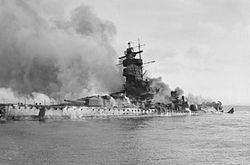
Back أمريكا اللاتينية خلال الحرب العالمية الثانية Arabic Histoire de l'Amérique latine pendant la Seconde Guerre mondiale French America Latina nella seconda guerra mondiale Italian América Latina durante a Segunda Guerra Mundial Portuguese 第二次世界大战中的拉丁美洲 Chinese
| Latin America during World War II | |
|---|---|
 Following the Battle of the River Plate, the German Deutschland-class cruiser Admiral Graf Spee was scuttled by her crew off Montevideo, Uruguay, on December 17, 1939. | |
| Location | Latin America |
| Date | 1939–1945 |
| Events | The St. Louis Affair – June 1939 Battle of the River Plate – December 13, 1939 Operation Bolivar begins – May 1940 Sinking of the Toltén – March 13, 1942 The Lüning Affair – August 1942 The sinking of U-176 – May 15, 1943 Revolution of '43 – June 4, 1943 The Strike of Fallen Arms – May 5–11, 1944 The Panama Canal strike – June 1945 |

During World War II, a number of significant economic, political, and military changes took place in Latin America. The war caused considerable panic in the region as large portions of their economies depended on trade with the European market, which was completely disrupted due to the war. Latin America tried to stay neutral at first but the warring countries were endangering their neutrality. In order to better protect the Panama Canal, combat Axis influence, and optimize the production of goods for the war effort, the United States through Lend-Lease and similar programs greatly expanded its interests in Latin America, resulting in large-scale modernization and a major economic boost for the countries that participated.[1]
Strategically, Panama was the most important Latin American nation for the Allies because of the Panama Canal, which provided a link between the Atlantic and Pacific Oceans that was vital to both commerce and defense. Brazil was also of great importance because of its having the closest point in the Americas to Africa where the Allies were actively engaged in fighting the Germans and Italians. For the Axis, the Southern Cone nations of Argentina and Chile were where they found most of their support, and they utilized it to the fullest by interfering with internal affairs, conducting espionage, and distributing propaganda.[1][2][3]
Brazil was the only country to send troops to the European Theater, was instrumental in providing air bases for the resupply of the combatants, and had an important part in the anti-submarine campaign of the Atlantic. Several other countries also had skirmishes with German U-boats and cruisers in the Caribbean and South Atlantic. Mexico sent a fighter squadron of 300 volunteers to the Pacific, the Escuadrón 201, known as the Aztec Eagles (Águilas Aztecas).
The Brazilian active participation on the battlefield in Europe was sought after the Casablanca Conference. The President of the U.S., Franklin D. Roosevelt on his way back from Morocco met the President of Brazil, Getulio Vargas, in Natal, Rio Grande do Norte. This meeting is known as the Potenji River Conference, and defined the creation of the Brazilian Expeditionary Force.
- ^ a b Leonard, Thomas M.; John F. Bratzel (2007). Latin America during World War II. Rowman & Littlefield. ISBN 978-0742537415.
- ^ "Cryptologic Aspects of German Intelligence Activities in South America during World War II" (PDF). David P. Mowry. Archived from the original (PDF) on September 18, 2013. Retrieved August 9, 2013.
© MMXXIII Rich X Search. We shall prevail. All rights reserved. Rich X Search